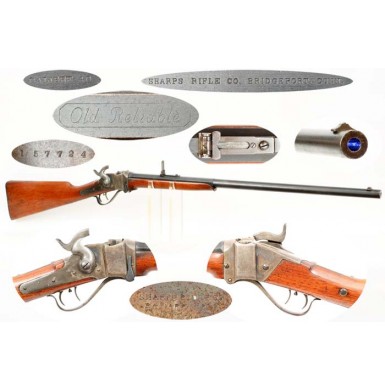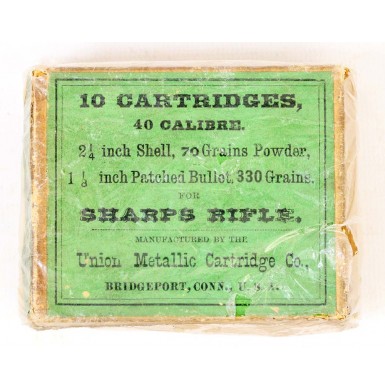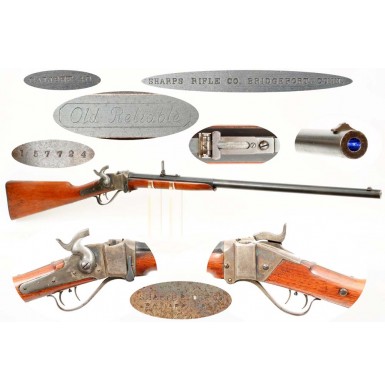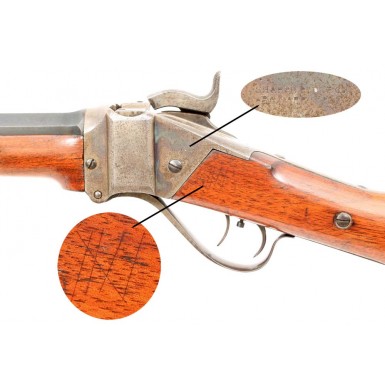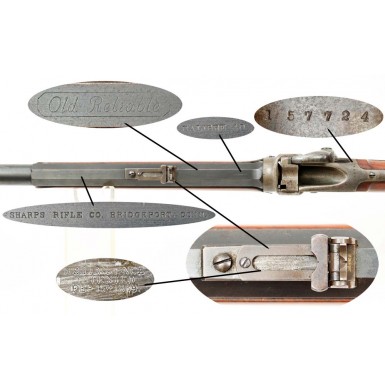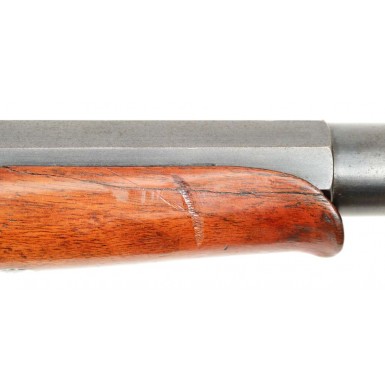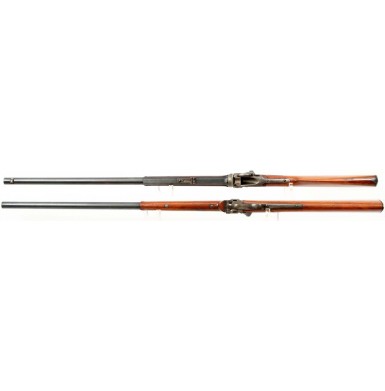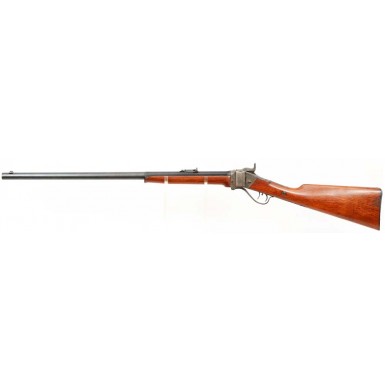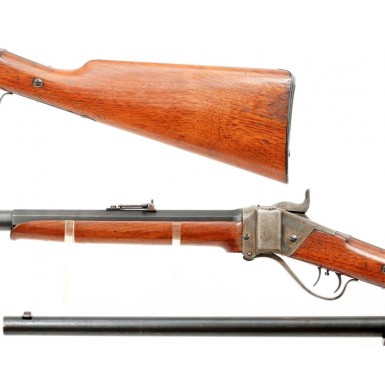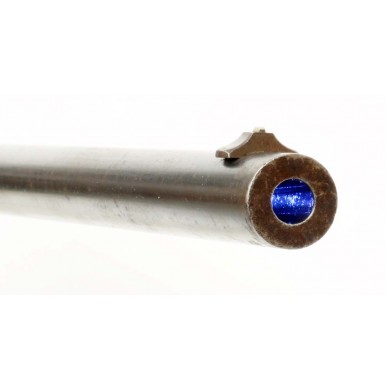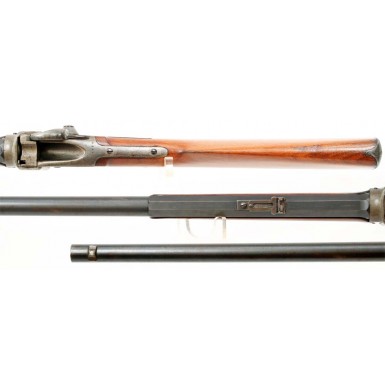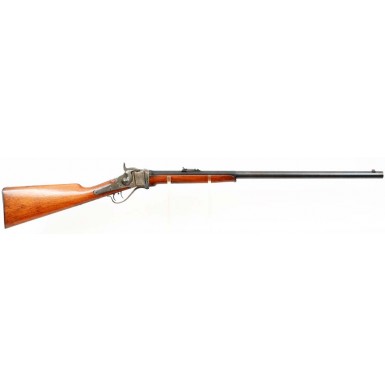Popular culture would have most people believe that the “Wild West” was won by men wielding Winchester lever action rifles and Colt Single Action revolvers. However, I think it can be argued that Sharps M-1874 Sporting Rifle did more to tame the west and cause the demise of the native tribes of the Great Plains, than any other American made firearm. The M-1874 Sharps Rifle has gained an appropriately iconic place in the lore of the American west, and when long range and large caliber guns are thought of, most people immediately think of the classic falling block Sharps. Christian Sharps is probably responsible for designing the most successful and recognizable family of breechloading arms of the 19th century. Sharps’ early training in the field of firearms had occurred at the Harpers Ferry Arsenal in Virginia, where he went to work in 1830 under the supervision of gun designer and pioneer of parts interchangeability, John Hall. Sharps worked at Harpers Ferry for over a decade, learning the arms making trade, as well as the early concepts of assembly line production. In 1848 Sharps received his first patent for a breech-loading carbine. The first Sharps patent firearms were produced by A.S. Nippes of Mill Creek, PA in 1849 and 1850. By 1851, Sharps formed the Sharps Rifle Manufacturing Company in Hartford, CT. As the company was not yet ready to produce arms, Sharps entered into an agreement with Robbins & Lawrence of Windsor, VT to manufacture his arms. By 1852 RS Lawrence (formerly of Robbins & Lawrence) moved to Hartford and became the master armorer of the Sharps Rifle Company. Over the next 7 years, Sharps produced a variety of carbines and rifles of various patterns, with each new pattern an attempt to improve upon his earlier designs. Several thousand arms were produced by Sharps during this time both for various US government contracts and for sale to the general public. Sharps really struck gold with the introduction of his “New Model” 1859 series of breechloading percussion carbines and rifles, which he subsequently improved upon with his “New Model” 1863 pattern. During the Civil War, Sharps produced thousands of carbines and rifles for the US government with more than 77,000 of his carbines being purchased for use by the US military! While the Spencer might have shot quicker with its repeating action and 7 round magazine, no carbine was more beloved for its sturdy reliability in the field and proven accuracy than the Sharps. By the end of the American Civil War it had become clear that the percussion era was also reaching its end and that self-contained metallic cartridges were the future of firearms designs. Few percussion rifle designs were as readily adaptable to the metallic cartridge as was the Sharps, and by 1871 the company was producing the breechblock and action that would be the heart of the M-1874. Why the company designated the guns as M-1874, when they had technically been produced as early as 1871 is unclear, but what is obvious is that the M-1874 Sporting Rifle changed the way that people thought about hunting and target shooting, and how they thought about cartridge power. The rifles were only produced in four bore sizes, .40 caliber, .44 caliber, .45 caliber and .50 caliber, however they were produced in a wide array of chamberings, based upon their intended use. For example, many shooters of the period felt that the .40 bore sized was inherently the most accurate of the Sharps offerings. As a result, a target shooter might order the rifle in .40-65 while a big game hunter might order it in .40-90. To make the chamberings and caliber designations even more confusing, some of cartridges with different names could be used in the same chamber. For example, the .40-90 was a heavy hitting 2 5/8” long bottleneck cartridge that propelled a 370 grain bullet at 1,475 feet per second, resulting in a muzzle energy of 1800 foot-pounds. The .40-100 was the exact same chambering physically (the cartridges would interchange in the breech), but was an early high-velocity “express’ cartridge, propelling a light-weight 190 grain bullet at a much higher rate of speed. The smaller, lighter bullet also allowed the inclusion of an additional 10 grains of power (100 grains) over the standard “big game” load of 90 grains. These “express’ loads had less “knock-down” power than the standard loads, but had the ability to penetrate large game deeply, allowing even a long distance quartering shot to hit vital organs. The loads also had the advantage of flatter trajectories over long range and retained their killing power at increased distances. The wide variety of chamberings available in the M-1874 Sporting Rifle line, and the variety of options and features available on each rifle, resulted in the production being more like that of a custom rifle shop rather than a factory that was mass producing arms. In addition to the numerous calibers offered, the rifles were available with a wide variety of sights, single or double set triggers, various buttstock contours and buttplates, various barrel styles, lengths, and weights, and nearly every other option you could think about including on a rifle during the 1870s. The rifle was in production from January of 1871 through September of 1880, and during that time slightly less than 6,500 of the M-1874s were produced (6,441 to be exact). The large majority of which had full octagon barrels. The typical gun varied in weight from 7 to 25 pounds and the two most common chamberings were .44-77 and .45-70. The standard gun started at $33, but the price could dramatically increase depending upon the features and options the buyer selected to include on his rifle. The rifles were initially produced at the Hartford, CT factory that had been the Sharps Company’s home since before the Civil War, but in 1876 production moved to a newly built factory in Bridgeport, CT. The Sharps M-1874 became the favorite of the professional buffalo hunter working on the western great plain, and these rifles (and the men who wielded them) managed to decimate the herds in a little over a decade. Between 1871 and 1884, the mass herds of North American Bison were all but destroyed, and with their destruction, the fate of the Native Americans who live on the plains and off those herds, was sealed. The typical “buffalo rifle” was chambered for a “big game” cartridge, had a full octagon barrel and weighed between 12 and 14 pounds. Initially the hunters favored larger caliber guns (usually a “.50”) and worked at fairly close range, with 200 to 400 yard shooting positions being common. By the latter half of the 1870s the herds had become warier, and hunters were often forced to work at ranges from 500 to nearly 1,000 yards. As a result the “big 50” chamberings became less popular and .44 and .45 caliber chamberings became more common, as the cartridges had longer effective ranges. The .40-90 (.40-100) cartridge was an attempt to squeeze even more range out of the cartridges, and during the latter portion of the buffalo hunting era, 1 in 8 Sharps rifles ordered for delivery in the west were chambered in .40-90 for long range shooting.
The Sharps M-1874 Sporting Rifle offered here is an extremely rare example that has an octagon to round barrel configuration. The large majority of the of M-1874s had full octagon barrels and only 387 rifles (about 6% of the total production) had this graceful, weight saving octagon to round barrels. The rifle is chambered for the Sharps .40 2 ““ Bottleneck Cartridge, better known as the .40-70 Necked (to differentiate it from the .40-70 Straight), and propelled a 330 grain round nosed, paper patched bullet at about 1,420 feet per second with a charge of 70 grains of black powder. The necked cartridge was designed for both long range shooting and accurate shooting. The half-round half-octagon barrel is 28” long and is marked on its bottom 4 15/16, indicating its weight as 4 pounds and 15 ounces. This reduced barrel mass allows the rifle to weigh in at a very comfortable 9 “ pounds, while a similar rifle with a full octagon barrel would weigh about 4 pounds more, around 13 pounds. The rifle is equipped with double set triggers, and a standard Lawrence Patent buckhorn style ladder rear sight. The lack of a tang sight suggests that this was intended to be a working hunting rifle at realistic ranges, rather than a target or long range hunting gun. The rifle is serial number 157724, and according to the Sharps factory ledgers was shipped on August 9, 1878. The serial number appears on the upper receiver tang and under the barrel (hidden by the forend). The last four digits of the serial number, 7724 appear on the inside of the lock and inside the forend. The left side of the receiver is marked in two lines: SHARPS RIFLE CO. / PAT. APR. 6, 1869. The top of the octagon portion of the barrel is marked just in front of the receiver, CAL 40. The top of the barrel is marked in front of the rear sight, SHARPS RIFLE CO. BRIDGEPORT. CONN, and the Sharps’ company trademark Old Reliable is stamped to the rear of the sight, in an octagonal cartouche with rounded edges. As noted, the rifle was produced in 1878, and a copy of the factory records letter accompanies the gun. The “factory letter” is from Dr. R.L. Moore Jr. of Philadelphia, MS, and is dated April 14, 1871. The particulars found in the Sharps factory records regrading this rifle are confirmed in the letter. At the time, Dr. Moore was the owner of the Sharps factory ledgers and would provide a research letter on a gun for the nominal fee of $5.00. The original type written letter was apparently lost at some point in time, but an old photocopy of the letter is included with the rifle. The letter notes that the rifle was priced at $42 dollars, and the factory weight of 9 “ pounds was listed. The M-1874 Sharps Sporting Rifle was shipped from the Bridgeport, CT factory on August 9, 1878 to J. Griffith & Sons, Louisville, KY. Joseph H. Griffith was a dealer in gun locks, derringers, general firearms and related material who established himself in 1843 and remained in business through 1878. The last four years, 1874-1878, the firm operated as Joseph Griffith & Sons. The letter confirms configuration of the gun, including the 28” “ octagon - “ round barrel, double set triggers, and the .40 caliber 2 ““ bottleneck chambering. The letter notes that the rifle was shipped with another gun of the same configuration, as well as with the necessary loading tools and loading components (bullets, cases, etc.) for the owner to manufacture ammunition for both rifles. At $9 more than the standard price of an M-1874 Sporting Rifle (an increase of about 27%), it is evident why not many of the more expensive octagon to round barrels were ordered. For the basis of comparison, using a combination of factors including both commodity value over time and the change in the value of wages from 1878 to 2015 (see measuringworth.com), the standard $33 Sharps rifle would cost $10,500 today and the $42 variant offered here would cost about $11,900. In both cases the greatest reason for the increase in their cost is due to the use of skilled labor in the production of the rifle, and not the percentage of increase in the Consumer Price Index.
This Sharps M-1874 Sporting Rifle is in about FINE to VERY FINE overall condition. All of the markings remain crisp and sharp and the rifle appears to be 100% complete, original and correct as it left the factory. The barrel retains the large majority of its original blued finish, probably about 60%+. The blue does show some wear, fading and thinning from handling and use but shows no damage or abuse. The octagon section of the barrel shows most of its loss at the sharp edges where the flats meet, and retains slightly more blue overall blue than the round section which was apparently handled more during the working life of the rifle. There are some flecks of minor surface oxidation and tiny freckles of age discoloration scattered along the barrel and mixed with the original blue, and the areas where the bluing has worn down to the base metal have an attractive and smooth plum brown patina. The barrel is almost entirely smooth, with only some lightly scattered pinpricking and lightly scattered hints of minor surface oxidation present. Both Lawrence Patent rear ladder sight and the dovetailed front sight appear to be completely correct and original to the rifle. The rear sight bears the usual Lawrence Patent information on its base, under the ladder. As is typical and correct for these rifles, the ladder is unmarked, as it was assumed the ladder would be graduated by the user after he had completed his load development, allowing him to customize his sight graduations to the load he used in the gun. The bore of the rifle is in VERY FINE condition and remains mostly bright. It retains very crisp 6-groove rifling with very narrow grooves and a relatively fast rate of twist. There is only some light pinpricking along its entire length along with some some light pitting scattered along it as well. The bore of the rifle should shoot very well with the right loads. The rifle’s receiver retains about 30% of its original vividly mottled case coloring, with the balance of the block having a pewter-gray to brown patina with some scattered flecks of brownish surface oxidation and some small areas of darker age discoloration. The receiver is mostly smooth, but does shows some evenly distributed pinpricking and some small areas of light pitting as well. The action of the rifle operates perfectly. The breechblock moves smoothly and locks securely into place. The extractor function correctly and appears to have more than enough power to easily remove even a tight case from a fouled chamber. The hammer and set trigger mechanism both function crisply correctly and are in excellent mechanical condition. The rear trigger “sets’ the front trigger when pulled, and the front trigger pull is extremely crisp and clean with no take up at all and a very light break that is certainly under 2 pounds. The receiver tang retains about the same amount of mottled vivid case colors as the receiver and matches the balance of the action perfectly. The checkered shotgun style buttplate has a dark bluish patina with brownish tones that matches the balance of the gun well. It shows some very lightly scattered pitting and surface oxidation. The screws all remain crisp and sharp with minimal slot wear. Most of the screws retains a significant amount of their original blue, although most of it has faded and dulled somewhat with age. The wood buttstock is in about FINE condition, with the usual assortment of bumps, dings, and minor bruises, as would be expected on a late 19th century big game rifle. The buttstock is solid and complete and free of any breaks, cracks or repairs. The Schnabel style forend of the rifle rates about VERY GOOD. The forend has a minor crack on the obverse that runs diagonally for about 2 ““ from the tip up to the barrel channel. There is an internal glue repair to stabilize this crack, but a more talented wood man could likely improve the stability and make the crack less obtrusive as well. The forend shows some handling marks and dings as well, and has a similar overall appearance to the buttstock. Neither the buttstock or the forend show any signs of having been sanded and retain a nice, unmolested appearance. The reverse of the buttstock has five tally marks lightly scratched into it where the wrist meets the frame. They are in the typical style with four upright and the fifth running through the other four as a diagonal line. There is no way to know what these five “kill” marks represent. The rifle is accompanied by a couple of nicely displaying accessories. An original box of 330 grain, .40 caliber bullets is included. The box retains 24 of the 25 bullets and has a nicely printed green label from the Union Metallic Cartridge Company, also of Bridgeport, CT. An empty box of 10 UMC .40 caliber Sharps 2 ““ cartridges is also included. Both items make nice accessories to add to the display of the gun. As previously noted, a copy of the research letter provided by Dr. Moore for the gun is also included.
Overall, this is an extremely attractive, and particularly scarce variant of the Sharps M-1874 Sporting Rifle. The gun is a really attractive rifle that was produced at the height of the western expansion and buffalo-hunting era. While Louisville is certainly not as alluring a shipping destination as Denver or some other western city would have been, it certainly makes sense. Cities like Louisville, St. Louis and Cincinnati were major jumping off points for eastern travelers heading west, and were often the last places that such people could make major purchases in. It seems more than likely that this rifle may have been initially shipped to Louisville and then proceeded further west in the hands of its new owner. The fact that only about 6% of the total production of M-1874 Sharps Rifles have the half-round half-octagon barrel, and that configuration is confirmed in the Sharps factory records make this and extremely rare variant that is very hard to find today. The rifle is rare enough and in nice enough condition to be a fabulous addition to an advanced collection of Sharps”, but also offers the potential to be a great gun on the range as well. This rifle offers a fine and crisp bore with a superior double set trigger mechanism, and would be one heck of a great rifle for long range shooting and hunting, or for a Cowboy Action Shooting side match. While it retains much original finish it is not so minty that you would be afraid to actually take it out and shoot it. As such it offers that rare combination of collectible condition and rarity coupled with some real shooting potential, that would allow this to be a wonderful addition to your gun collection and an addition to your working arsenal as well. I am very sure you will be quite proud to add this gun to your collection of fine rifles from the American West.
SOLD
